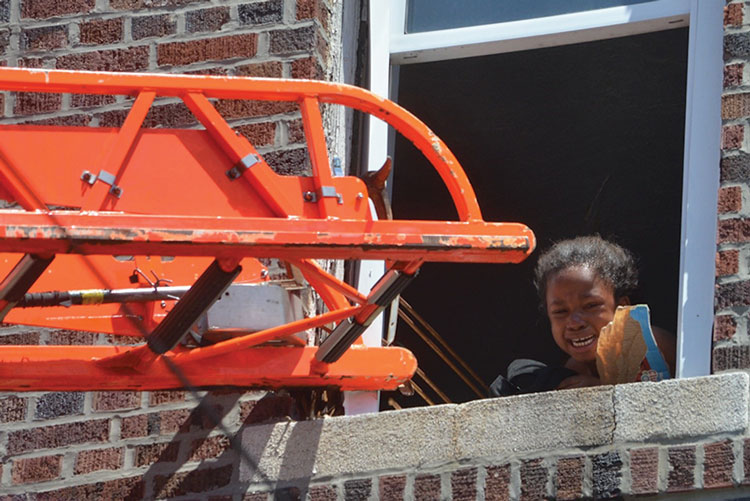
By Daniel Stratton
on a floor above the fire’s origin is the most hazardous place for search and rescue groups to operate. In Wilmington, Delaware, on September 24, 2016, Lieutenant Christopher Leach, 41, and Firefighter Jerry Fickes, 51, perished from injuries sustained while conducting such an operation. Firefighter Ardythe Hope was in critical condition and died of her injuries 61 days later. Firefighter Brad Speakerman, who sustained burns over 30 percent of his body, was hospitalized for 41 days. This fire was in a row home and originated in the basement. It’s suspected that a floor collapse as the crews were conducting search and rescue may have contributed to the tragedy.
 |
| (1-4) Note the time stamp on the four photos. This is a testament to how fast fire can communicate to the floor above. (Photos by the late Steve Skipton.) |
Hazards
The primary hazard is the fire itself; it will consume and distort structural elements, which can lead to collapse. Furthermore, the tendency of the by-products of combustion is to travel upward, engulfing, trapping or disorienting firefighters on upper floors.
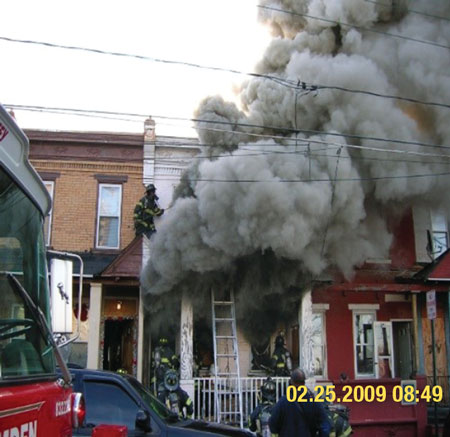
The smoke can lead to personnel searching on floors above blindly, which can contribute to disorientation or make them prone to falling into an opening they cannot see in the dark smoke. Such an accident claimed the life of Cincinnati Firefighter Daryl Gordon, who fell down an elevator shaft while searching on a smoky ninth floor. The fire was on the second floor.
The fire can spread to upper floors from flames lapping out of openings on a floor below. Hot gases emanating from below can accumulate above and radiate on fuel packages, contributing to flashover. The threat of wind can accelerate or push fire to engulf or trap crews.

The fire’s ability to weaken primary structural elements can lead to floor collapse, causing search groups to fall into a fiery area below. Be ever so mindful of fire’s consumption and deformation of load-bearing walls, columns, and girders. When compromised, a floor loses its ability to defy gravity and can release.
The floor decking may burn, allowing members to plunge into or completely through the decking. Preexisting openings can jeopardize members as well. Firefighters must sound the floor with a tool to test its stability or probe the floor for the presence of holes in poor visibility.
Precautionary Measures
To stay safe in a structure on fire when operating above the fire, suppression personnel should implement precautionary measures at every incident. The first consideration in firefighter survival is to gain and maintain situational awareness by completing a comprehensive and ongoing size-up of the overall scene.
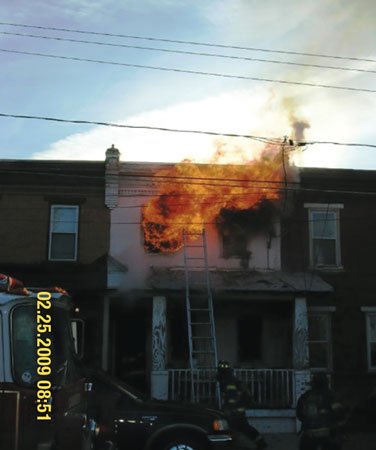
Note the construction of the fire structure; the size, location, and status of the fire; and the dynamics of the by-products of combustion. These clues can aid in predicting fire spread and structure collapse. To enhance these abilities takes training and study to strengthen your ability to make informed decisions.
The best safeguard on a working fire scene is to immediately apply water on the fire. This tactic saves the most lives of trapped civilians and firefighters. The second best tactic in keeping personnel safe is to place ladders on upper floors. If firefighters inside need to egress hastily, it is best done by way of a ground or an aerial ladder. If ladders are not present because staffing has not allowed for the perfect timing in an operation or the height of the building does not allow for placement, personnel should be trained and equipped to egress a structure through rappel. At a minimum, they should carry a 50-foot piece of rope they can use to form a body belay by wrapping the rope around themselves and then dropping out of a widow for rappel. A recommended, much safer, more efficient option is to use a class 2 harness equipped with an escape system. The device is a lot more expedient in deploying in a hurry.
Independently of a Hoseline
If you are part of a search group operating above the fire before a water supply is available or without an operating hose stream below, various tactics should be implemented. Note that doing this should be left to individuals who are well trained and experienced. If you do not have the utmost faith in a crew when considering this risky operation, wait for water to be applied first.
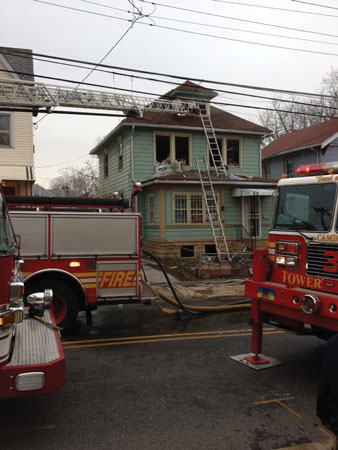 |
| (5) After stream placement, setting up aerials and ladders is the next best tactic to implement. They improve firefighter safety and increase the chance for survival. (Photo by Joel D. Bain.) |
Keep the fire’s flow path in mind. To control this phenomenon, do not ventilate prematurely. Doing this will cut off the means of egress by pulling the products of combustion toward the firefighters. Also, close doors as the search operation proceeds. This action will keep the heat and smoke at bay and diminish the results of wind-driven fires.
When on a floor above the fire, your primary concern is egress, not the civilians you are looking to rescue. Most authors recommend starting your search above a fire floor as soon as you enter that floor. Unless you are conducting vent-enter-search of a specific room for a known trapped victim, I recommend that as soon as you are on the floor, immediately go to an opposite end of the floor to find an egress point first, such as a window. Then after finding this second means of egress, start your search but continually search for other escape options.
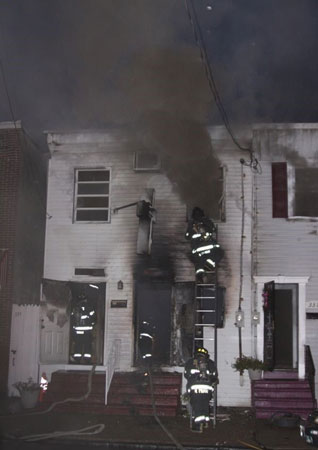 |
| (6) On entering a floor above to operate, the number-one priority is to find a second means of egress. (Photo by the late Steve Skipton.) |
Be sure to communicate and coordinate with command; all groups and divisions; and particularly with the attack group below. Radio the attack team that you are operating on the floor above. Be mindful of its status in making progress on suppression. If necessary, identify the floor and area for the command staff so that your crew’s exact location is known for accountability purposes.
Rescue and Removal
On finding a viable victim on a floor above, determine the path of removal. Keep in mind that the interior stairs may not be the best option for a fire victim who’s not wearing gear or breathing apparatus. The best option may be by ladder or fire escape. First, move the victim into a room if you are not already in one. Of course, shut the door and break a window; these two actions can help to preserve life. Then consider removal options. However, if a ladder is already placed within reach by a window that has been taken out, certainly take that immediate route. The idea is to give the victim some fresh air as soon as possible. You do not want to expose a victim to a more dangerous atmosphere than the one in which he was found.
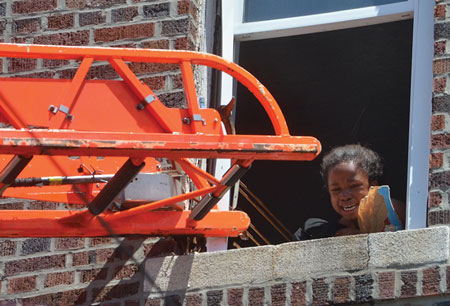 |
| (7) When removing victims on a floor above, consider the least contaminated and hazardous route. Remember, victims do not have the same protection firefighters are wearing. (Photo by Lloyd Mitchell.) |
Firefighters conducting search and rescue above the fire are facing a challenge; however, smart tactics, immediate stream placement, throwing ladders, and ensuring a means of escape in haste without the presence of ladders will improve their chances of survivability. Remove a survivable victim found above the fire floor by the route that is least contaminated by the fire’s by-products.
DANIEL STRATTON is a 28-year veteran firefighter, with experience as a volunteer, U.S. Army, and career firefighter. He is a captain with the Camden City (NJ) Fire Department, a course coordinator at the Camden County Emergency Training Center, and an instructor for Safety and Survival LLC. He is a rescue specialist with New Jersey’s USAR team. He has a dual associate degree in fire science from Camden County Community College.
Daniel Stratton will present “Operating on a Floor Above” at FDIC International in Indianapolis on Thursday, April 27, 2017, 3:30 pm-5:15 pm.
Search Operations On The Floor Above
Above the Fire Floor: Hazards and Precautions
THE FLOOR ABOVE
THE FLOOR ABOVE, PART 3
THE FLOOR ABOVE, PART 4
THE FLOOR ABOVE, PART 5
Hey, We’re Going Above
Fire Engineering Archives

